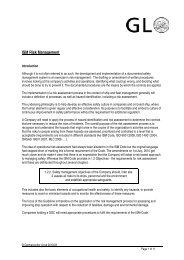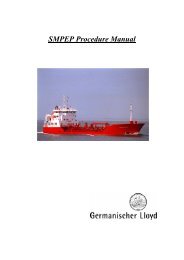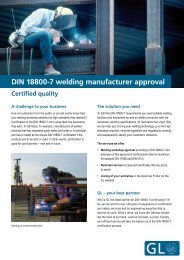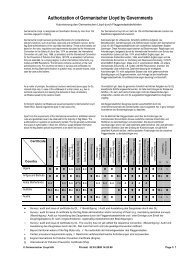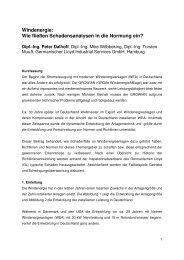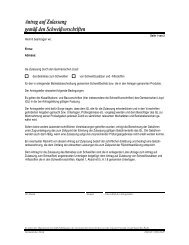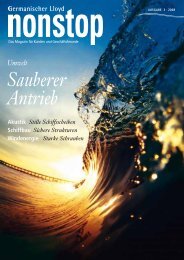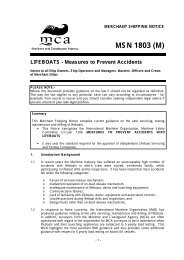Yards Moving Forward - GL Group
Yards Moving Forward - GL Group
Yards Moving Forward - GL Group
Create successful ePaper yourself
Turn your PDF publications into a flip-book with our unique Google optimized e-Paper software.
“made in Germany”<br />
PHOTOS: MICHAEL HOLLMANN<br />
It is well known that, in striving for perfection, Germans<br />
tend to complain a lot – and German managers are no<br />
exception. The leaden inertia of the bureaucracy and the<br />
over-regulation by the state are amongst the enduringly<br />
popular topics for a good gripe. Or could these aspects represent<br />
an advantage? Peter Breidenich, for one, does not fit into<br />
the role of a moaner. The former chief engineer of a destroyer<br />
is Head of the Marine Systems Division of Saacke GmbH & Co.<br />
KG in Bremen, one of the world’s leading manufacturers of<br />
burner systems. The question as to how one could improve<br />
the general business conditions in Germany initially causes<br />
him to reflect in silence. “Actually, we regard the economic<br />
environment to be quite good,” he answers with some hesitation.<br />
“Germany is a very important market for us, because the<br />
technically demanding ships are still built here. As a marine<br />
supplier, we have our finger on the pulse of developments<br />
here, and we can watch new technological trends as they<br />
emerge.”<br />
The company, which generates a turnover of more than<br />
130 million euro worldwide (of which 25 percent is in shipbuilding)<br />
with about 800 employees, has managed to grow<br />
from a subcontractor to a system supplier, thanks to a lot of<br />
ingenuity and a sure instinct. Burners and boilers are needed<br />
for just about any type of ship, be it for providing hot water,<br />
heating the accommodation spaces or warming up the fuel in<br />
the bunker und day tanks, in order to make the heavy fuel-oil<br />
liquid enough for combustion. Up until a few years ago, the<br />
distribution of labour functioned as follows: Saacke delivered<br />
YARDS MOVING FORWARD<br />
Things are going better than ever before for the German maritime and offshore supply industry.<br />
Many companies have internationalized strongly but remain firmly rooted in Germany.<br />
For them, the home country is an important sales market and at the same time a field for<br />
experimenting with new technologies.<br />
Impressions of the burner production at Saacke Marine in Bremen.<br />
Peter Breidenich, Head<br />
of Saacke Marine<br />
Systems<br />
“Germany<br />
is a very<br />
important<br />
market<br />
for us”<br />
the burners to the boiler manufacturers, who integrated all<br />
the components and then sold the complete installations to<br />
the yards. But when a concentration took place amongst the<br />
boiler makers towards the end of the nineties, and several<br />
of Saacke’s partners were taken over or squeezed out of the<br />
market, the future of this business was suddenly very shaky<br />
indeed. The company bravely decided to take the bull by the<br />
horns: to be able to approach the European yards with their<br />
own complete systems, the medium-sized enterprise decided<br />
to acquire a burner manufacturer in Croatia. In 2003, this<br />
move was followed by the founding of their own factory in<br />
China, with a view to serving the Asian market better. Whilst<br />
the steel parts are built overseas, the burner and control technology<br />
still comes from Bremen and is combined at the yards<br />
with the matching boilers from China or Croatia. “We have<br />
made global networking work well for us,” says Breidenich<br />
with some satisfaction. Thanks to their presence in all the<br />
major shipbuilding markets, Saacke Marine is benefiting in<br />
full measure from the current shipbuilding boom. This year,<br />
about 160 plants will be delivered, boosting the firm’s<br />
turnover by 15 percent from its previous figure of 30 million<br />
euros. The fast movers in the delivery programme are the firing<br />
plants for LNG carriers, with which the “boil-off” part of<br />
the gas cargo that is produced by the ship’s motion and solar<br />
radiation can be burnt safely. “The explosive gas is thus converted<br />
into CO 2 , which is still better for the atmosphere than<br />
methane,” explains Breidenich. These gas combustion units<br />
pack quite a punch: as a result of the combustion process, an<br />
output of up to 80 MW is released.<br />
nonstop 3/2006 21






